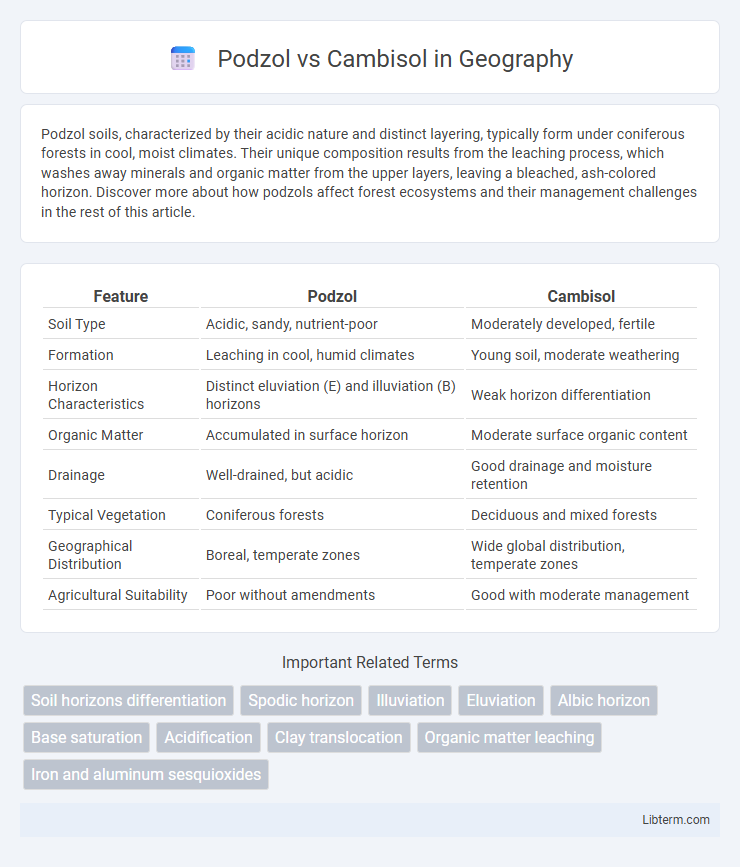Podzol soils, characterized by their acidic nature and distinct layering, typically form under coniferous forests in cool, moist climates. Their unique composition results from the leaching process, which washes away minerals and organic matter from the upper layers, leaving a bleached, ash-colored horizon. Discover more about how podzols affect forest ecosystems and their management challenges in the rest of this article.
Table of Comparison
| Feature | Podzol | Cambisol |
|---|---|---|
| Soil Type | Acidic, sandy, nutrient-poor | Moderately developed, fertile |
| Formation | Leaching in cool, humid climates | Young soil, moderate weathering |
| Horizon Characteristics | Distinct eluviation (E) and illuviation (B) horizons | Weak horizon differentiation |
| Organic Matter | Accumulated in surface horizon | Moderate surface organic content |
| Drainage | Well-drained, but acidic | Good drainage and moisture retention |
| Typical Vegetation | Coniferous forests | Deciduous and mixed forests |
| Geographical Distribution | Boreal, temperate zones | Wide global distribution, temperate zones |
| Agricultural Suitability | Poor without amendments | Good with moderate management |
Introduction to Podzol and Cambisol
Podzol soils are characterized by acidic conditions and distinct horizon differentiation, often occurring in coniferous forest regions with high precipitation and sandy parent material. Cambisols represent soils with moderate horizon development, typically found in temperate climates on varied parent materials, exhibiting enhanced fertility compared to Podzols. Both soil types play critical roles in ecosystem processes, influencing vegetation growth and nutrient cycling.
Definition and Formation of Podzol
Podzol is a soil type characterized by a distinct horizon sequence formed through intense leaching and organic acid activity, resulting in a bleached, acidic upper layer and a dark, enriched sublayer. It typically develops under coniferous forests in cool, moist climates where organic matter decomposition produces organic acids that mobilize iron and aluminum. In contrast, Cambisol is a soil with less pronounced horizon differentiation, forming through moderate weathering and mixing processes, usually found in temperate regions with more balanced moisture and vegetation conditions.
Definition and Formation of Cambisol
Cambisol is a young, well-drained soil type characterized by minimal horizon development, formed primarily through the weathering of unconsolidated materials under temperate or tropical climates. Unlike Podzol, which develops distinct, leached horizons with accumulation of organic matter and iron/aluminum oxides, Cambisol's formation involves moderate soil profile differentiation due to physical and chemical weathering processes without intense leaching. Cambisols typically occur on slopes or areas with active erosion, where parent material and climate conditions allow moderate soil development but prevent deep horizon formation.
Key Physical Characteristics
Podzol soils exhibit a distinct horizon with a bleached, ash-gray eluvial layer due to leaching of organic acids, while Cambisol soils display more uniform and less differentiated horizons with moderate weathering. Podzols typically have a coarse texture, acidic pH, and low nutrient availability, contrasting with Cambisols that possess finer textures, neutral to slightly acidic pH, and higher fertility. Drainage in Podzols is often impeded by dense spodic horizons, whereas Cambisols show better permeability and aeration, influencing root development and microbial activity.
Chemical Properties Comparison
Podzols exhibit strong acidity with pH values typically ranging from 3.5 to 5.0, reflecting high levels of organic acids and aluminum saturation, which limit nutrient availability. Cambisols generally present higher pH levels, around 5.5 to 7.0, favoring greater base saturation and enhanced nutrient exchange capacity due to more balanced cation content, including calcium, magnesium, and potassium. The chemical differentiation between Podzols and Cambisols significantly influences soil fertility, with Cambisols supporting more robust plant growth due to their nutrient-rich chemical profile.
Distribution and Occurrence Worldwide
Podzols predominantly occur in cool, humid regions with coniferous forests, commonly found across northern Europe, Russia, Canada, and parts of the northeastern United States. Cambisols have a more widespread distribution, forming under various climatic conditions, including temperate and tropical zones, and are extensively present in Europe, Africa, Asia, and North America. The contrasting climatic preferences and vegetation types largely define the geographic distribution of Podzols and Cambisols globally.
Agricultural Suitability and Usage
Podzols exhibit low fertility due to acidic, nutrient-poor conditions, limiting their agricultural suitability primarily to forestry and pasture crops adapted to acidic soils. Cambisols, featuring higher base saturation and better drainage, support a wide range of crops, including cereals, vegetables, and fruits, making them preferable for intensive agriculture. Soil management practices like liming and organic amendments can enhance Podzol productivity but Cambisols inherently offer more versatile agricultural usage.
Environmental Significance
Podzol soils, characterized by acidic conditions and leached horizons, play a crucial role in carbon sequestration and supporting coniferous forest ecosystems, despite their low fertility. Cambisols, with more balanced pH and nutrient availability, are vital for agricultural productivity and sustainable land management in temperate regions. Understanding the contrasting environmental functions of Podzols and Cambisols aids in optimizing soil conservation and ecosystem resilience strategies.
Management and Conservation Practices
Podzol soils require careful management to prevent nutrient leaching, often benefiting from the application of lime and organic matter to improve fertility and structure. Cambisol soils are more versatile, supporting diverse crops with practices such as crop rotation and reduced tillage to maintain soil health and prevent erosion. Both soil types benefit from conservation techniques like cover cropping and contour farming to enhance moisture retention and reduce degradation.
Summary: Choosing Between Podzol and Cambisol
Podzol soils are acidic, nutrient-poor, and typically found in cool, moist climates with coniferous forests, making them suitable for forestry and limited agriculture. Cambisols, characterized by better drainage and higher fertility, occur in temperate regions and support diverse crop production due to their well-developed nutrient profiles. Selecting between Podzol and Cambisol depends on land use goals, climate conditions, and soil management practices to optimize productivity and sustainability.
Podzol Infographic

 libterm.com
libterm.com